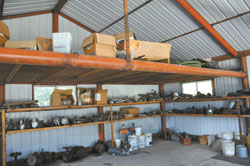
Kenny Cemper started installing irrigation systems in 1969. A few years later, he made his first calving shed out of discarded pipes that he had replaced.
"Ranchers just loved the sheds," says Cemper, who has built nearly 20 of them. Then a gas station owner asked him to build a 40 by 60-ft. shed for storing bulk oil barrels. Since that time, Cemper has built many buildings out of irrigation pipe.
"The main thing is that you make it perfectly square," Cemper emphasizes. "If you don't, you'll have problems with the steel siding. It's got to be perfect."
He starts by making straight cuts on the pipes, tearing out hoses, and welding holes shut. He squares up a base of large pipes and welds them together. Then he tack welds upright pipes every 9 to 10 ft. and welds another rung of pipes around the top. He measures often to make sure everything remains level and square before he makes final welds sometimes using a come-along to pull pipes into line.
He joins the vertical and horizontal pipes together with brackets made from angle iron. He welds longer pieces of the angle iron horizontally to the upright pipes for strength and to support the steel siding and roofing.
Cemper explains that the old irrigation pipe he uses comes in two gauges of steel. He uses the heavier gauge with 1/8-in. walls for the horizontal pieces and the lighter weight pieces for the uprights.
The sheds are welded to steel bars laid into concrete footings, or simply lag-bolted into the concrete. Cemper usually builds the frame in his Quonset building during the winter and moves the frame with angle supports on a trailer to the final site. He cuts out the pipe for door openings after it has been moved.
"I figure out dimensions so that they come out perfect with the steel siding and the overlap," Cemper says. A couple of his recent buildings were 30-ft. by 27-ft. for example. He added a loft in one made of recycled hog confinement grates supported by 5/16-angle iron every 2 ft.
His largest building was 40 by 60-ft. with 14-ft. walls. With the help of an assistant, he framed and put on the steel for the roof section on the ground and lifted the roof on to the irrigation pipe frame with six loader tractors.
With the welded angle iron supports, Cemper says he believes his sheds will outlast any commercial sheds on the market. Using recycled material for the frame also saves money.
